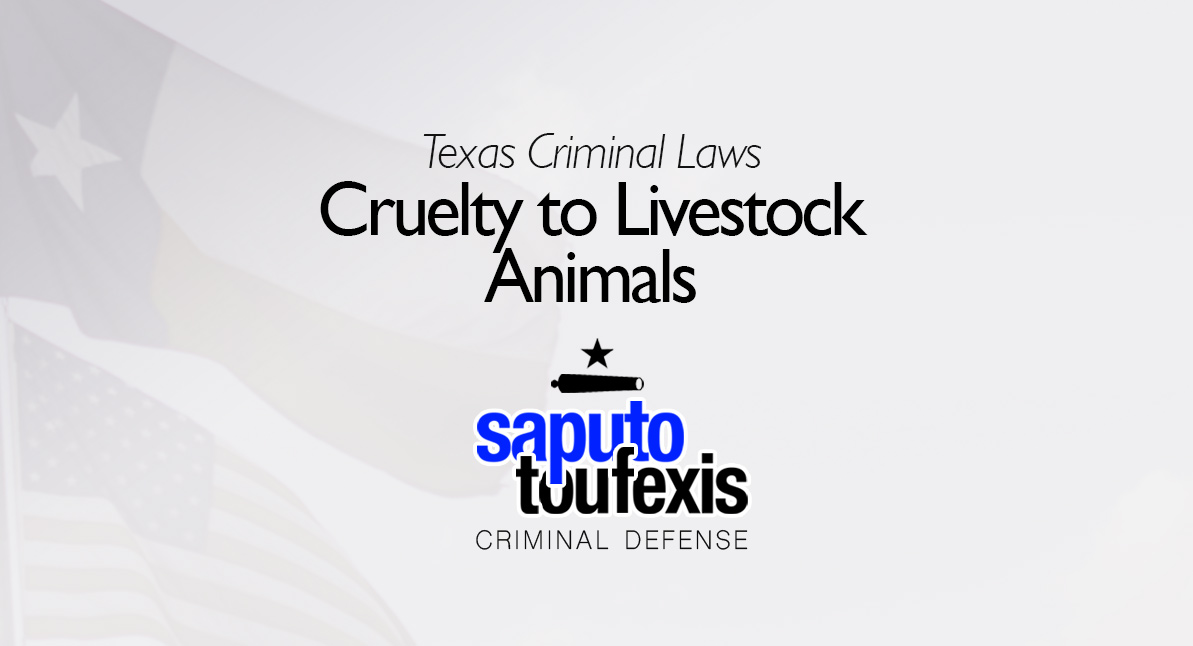The Texas Cruelty to Livestock Animals law gives police the right to arrest you if they believe you tortured, abandoned, overworked, or neglected a livestock animal, or if you tripped a horse or caused one animal to fight another.
FAQs about the
Cruelty to Livestock Animals law in Texas
- What is the current Texas law about Cruelty to Livestock Animals?
- What is the penalty for a Texas Cruelty to Livestock Animals offense?
- What are livestock animals?
- How can I be charged with a Cruelty to Livestock Animals offense in Texas?
- What is the statute of limitations for Cruelty to Livestock Animals in Texas?
- Can you get probation for Cruelty to Livestock Animals in Texas?
- What level of crime is Cruelty to Livestock Animals in Texas?
Cruelty to Livestock Animals cases typically involve sick or dead animals. As a result, these cases often involve the opinions of veterinarians and professionals in the livestock industry. Similar to this offense, the Cruelty to Nonlivestock Animals applies to domesticated and undomesticated animals like dogs, cats and wildlife.
Have you been charged with Cruelty to Livestock Animals? Contact us today to discuss legal representation.
or Text or Call (888) 239-9305
The Cruelty to Livestock Animals crime also covers causing animals to fight each other, but the two most common types of fighting animals, Dog Fighting and Cockfighting, each have their own distinct penal code section that prosecutors may use to obtain convictions.
The Texas legislature codified this criminal offense in Texas Penal Code Section 42.09. The legislature did not update this law in 2025. In fact, this law has not been amended since 2007.
The Penal Code classifies the Texas Cruelty to Livestock Animals law under Title 9 “Offenses Against Public Order and Decency,” Chapter 42 “Disorderly Conduct and Related Offenses.” Learn more about the Texas offense of Cruelty to Livestock Animals below.
What is the current Texas law about Cruelty to Livestock Animals?
AV Preeminent Texas lawyer Paul Saputo provides the current law defining Cruelty to Livestock Animals in Penal Code Section §42.09, as follows:[1]
(a) A person commits an offense if the person intentionally or knowingly:
(1) tortures a livestock animal;
(2) fails unreasonably to provide necessary food, water, or care for a livestock animal in the person’s custody;
(3) abandons unreasonably a livestock animal in the person’s custody;
(4) transports or confines a livestock animal in a cruel and unusual manner;
(5) administers poison to a livestock animal, other than cattle, horses, sheep, swine, or goats, belonging to another without legal authority or the owner’s effective consent;
(6) causes one livestock animal to fight with another livestock animal or with an animal as defined by Section 42.092;
(7) uses a live livestock animal as a lure in dog race training or in dog coursing on a racetrack;
(8) trips a horse; or
(9) seriously overworks a livestock animal.
What is the penalty for a Texas Cruelty to Livestock Animals offense?
If the offense falls under subsections (a)(2), (3) ,(4), or (9), a conviction for Cruelty to Livestock Animals is punished by default as a Class A misdemeanor,[2] with a maximum possible fine under Texas state law of up to $4,000 and jail time of up to one year.
However, if the offense falls under one of those subsections, and you have been convicted of this offense or the offense of Cruelty to Nonlivestock Animals two or more times, a conviction for Cruelty to Livestock Animals in Texas is punished as a state jail felony,[3] with a maximum possible fine under Texas state law of up to $10,000 and jail time of up to two years.
If the offense falls under subsections (a)(1), (5), (6), (7) or (8), then a conviction for Cruelty to Livestock Animals is punished by default as a state jail felony,[4] with a maximum possible fine under Texas state law of up to $10,000 and jail time of up to two years.
But if the offense falls under one of those subsections, and you have been convicted of this offense or the offense of Cruelty to Nonlivestock Animals two or more times, then a conviction for Cruelty to Livestock Animals in Texas is punished as a Felony of the Third Degree,[5] with a maximum possible fine under Texas state law of up to $10,000 and prison time of up to 10 years.
What are livestock animals?
The statute defines “livestock animals” as “(A) cattle, sheep, swine, goats, ratites, or poultry commonly raised for human consumption; (B) a horse, pony, mule, donkey, or hinny; (C) native or nonnative hoofstock raised under agriculture practices; or (D) native or nonnative fowl commonly raised under agricultural practices.”[6]
How can I be charged with a Cruelty to Livestock Animals offense in Texas?
You can be charged with Cruelty to Livestock Animals in Texas if the state’s attorneys believe that each of the elements of §42.09(a) as described in the section above have been met.
What is the statute of limitations for Cruelty to Livestock Animals in Texas?
Misdemeanor level Cruelty to Livestock Animals charges have a two-year limitations period.[7] Felony level offenses follow the default felony limitations period rule, which specifies a three-year limitations period.[8]
Can you get probation for Cruelty to Livestock Animals in Texas?
The Texas Code of Criminal Procedure allows both judges and juries to grant probation for Cruelty to Livestock Animals, and judges are also allowed to accept deferred adjudication plea deals.[9]
Note, however, that no matter the offense, neither judges nor juries may recommend community supervision for any suspended sentence of over 10 years.[10] Also, judges may not grant community supervision after a conviction if (1) the defendant used or exhibited a deadly weapon during the commission of the felony or immediate flight thereafter and (2) the defendant used or exhibited the deadly weapon himself or was a party to the offense and knew that a deadly weapon would be used or exhibited.[11]
What level of crime is Cruelty to Livestock Animals in Texas?
The classification for the Cruelty to Livestock Animals offense ranges from is a Class A misdemeanor to a third degree felony, depending on the circumstances.
Learn more about the penalty range for this offense in the section above.
Legal References:
^1. Texas Penal Code §42.09. This law is current as of 2025.^2. Texas Penal Code §42.09(c)^3. Texas Penal Code §42.09(c)^4. Texas Penal Code §42.09(c)^5. Texas Penal Code §42.09(c)^6. Texas Penal Code §42.09(b)(5)^7. Code of Criminal Procedure 12.02(a)^8. See Code of Criminal Procedure 12.01(11)^9. See Chapter 42A, Texas Code of Criminal Procedure, Art. 42A.054, Art. 42A.056, Art. 42A.102^10. Art. 42A.053(c), Texas Code of Criminal Procedure^11. Art. 42A.054(b), Texas Code of Criminal Procedure










